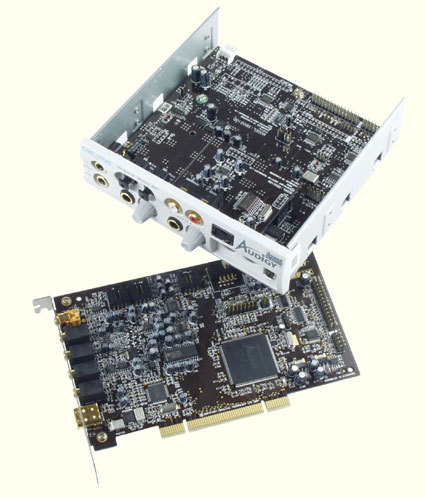Terratec DMX 6Fire 24/96 vs. Sound Blaster Audigy Platinum
Creative Labs Sound Blaster Audigy Platinum
| Creative Labs SB Audigy Platinum | |
|---|---|
| Manufacturer | Creative Labs |
| Interface | PCI |
| DSP | Audigy CA0100-IAF |
| Sound quality | 24 Bits - 96 kHz |
| Inputs / Outputs | |
| Card Inputs | Line In, Mic In, SB1394 |
| Rack Inputs | Line In, Mic In2, Midi In, Optical and Coaxial In SB1394 |
| Card Outputs | Front and back mini-jack, LFE + Central/SPDIF, SB1394, |
| Rack Output | Headphones, Midi Out, Line Out, Optical and Coaxial Out, SB1394 |
| 3D capacities | |
| Standards supported | DS3D, A3D 1.x, EAX 1.0/2.0 and HD |
| 3D sound management | Headphones, 2.1, 4.1 and 5.1 |
| Number of voices | 32 |
| Music capacities | |
| Midi characteristics | GM - SoundFonts |
| Capacities | RAM-dependent |
| Number of voices - softwareNumber of voices - hardware | 641024 |
| AD signal-to-noise ratio | 100 dB |
| DA signal-to-noise ratio | 100 dB |
| Price | $200 |
As a leading innovator in multimedia sound cards, Creative had to review its revered Sound Blaster Live! and the others which followed it without being as successful. Creative Labs adjusted its arsenal by developing the Audigy with a powerful and versatile multifunction DSP. It is officially called Audigy, though it is actually nothing more than the 10K2 by E-Mu, the famous music company taken over by Creative Labs. For more details, read our earlier article on the Audigy.
The Audigy Platinum not only has 32 bit processing but also includes an IEEE-1394 port and a new version of the EAX - the EAX Advanced HD. But be warned, the Audigy's ability to support 24 bit/ 96 kHz sound is very relative. Unlike the DMX 6Fire 24/96, the Audigy Platinum is not a "true" 24/96 and cannot play or record a file of this quality, nor even work on it. Actually, the only task it does in 96 kHz is a linkup with another device via the S/PDIF input. The card and rack components are all supposed to be 24 bit/ 96 kHz compatible, but, in practice, the card is limited to 16 bits/ 48 kHz. Analog recording and restitution is possible in 24 bits/ 48 kHz, but, in fact, the processor downsamples in 16 bits and then upsamples. The card also has to be used with the sample rate conversion (SRC) software provided in order to work in 44.1 kHz. It's just a pity that Creative has not given this product an automatic SRC hardware option by using, say, a Cirrus Logic CS8420 chip. And it's really a pity that the card is not completely 24 bit/ 96 kHz compatible. But the Audigy can model, process and position several sound sources separately and in real time.
The Audigy Platinum MIDI capabilities are fairly attractive. It uses the SoundFonts system, which can import instruments stored in your PC RAM to be used by the MIdI synthesizer. This makes a considerable number of instruments available if your PC has, say, 256 or 512 MB of RAM. As SoundFonts are customized, they can integrate anything you want in your MIdI, including your own voice. The card is a standard feature with a 4 MB SoundFont and support of 64 instruments. The only drawback with this system, which helps to overcome the constraints of the General MIdI banks, is that you have to remember which are the right SoundFonts if you want to reproduce a piece of sound. Fortunately, Creative has developed a system called Automatic SoundFont Support, which saves and loads the SoundFonts automatically whenever a piece is played. The Audigy has overcome another drawback by allowing all the instruments stored in the RAM to be used, whereas the old SB Live! was confined to 32 MB at a time.
The Audigy chip makes the Audigy Platinum very well-equipped for games. This not only manages DirectSound 3D, A3D 1.0x, EAX 1.0 and 2.0, but also EAX Advanced HD (High Definition). See the next page to find out more about this new standard. More technically speaking, the card supports up to 32 DS3D voices in hardware, which is quite ample for most games. Of course, 5.1 decoding is not left out, and the Audigy is compatible with Dolby Digital and DTS formats. The actual decoding is done by the processor with an occupancy rate of about 8% (on a Celeron 800 in our case). The management of the six channels is done by the Audigy DSP and a Philips UDA1328T chip. For DVD playback, the Audigy has prime assets in the shape of an infrared remote control and Remote Center software, so you can use your PC as a jukebox or DVD player.
The software bundle is a bit more extensive than that for the DMX 6Fire 24/96: Creative Diagnostic 2 Creative PlayCenter 3.0; Creative Recorder; Remote Center; Creative Task Bar; WaveStudio 4.12; Dolby Digital Music Samples EAX Advanced HD; MiniDisc Center 2.0; Oozic Reactor Vienna SF Studio 2.3; Sound Blaster Audigy Experience; MixMiester 3.03; FireNet 2.0 by Unibrain S.A.'s;
Storm Platinum Edition by Arturia Suite; Steinberg Cubasis VST Creative Edition (including WaveLab Lite and ReCycle Lite); SoundFont Collection by E-Mu; Ulead VideoStudio 4.0 SE Basic; plus a guide for creating music ( "Sound Blaster Audigy - The Definitive Music Creation Guide," by Paul White).
Get Tom's Hardware's best news and in-depth reviews, straight to your inbox.
Current page: Creative Labs Sound Blaster Audigy Platinum
Prev Page Terratec DMX 6Fire 24/96: The Rack Next Page Creative Labs Sound Blaster Audigy Platinum: Drivers
